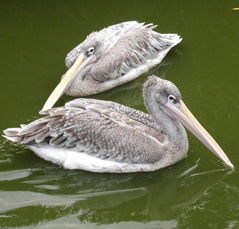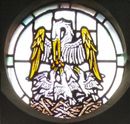|
Pelican |

Pink-backed Pelicans (Pelecanus rufescens).
|
|
Scientific classification |
| Kingdom: |
Animalia
|
| Phylum: |
Chordata
|
| Class: |
Aves
|
| Order: |
Pelecaniformes
|
| Family: |
Pelecanidae
Rafinesque, 1815 |
| Genus: |
Pelecanus
Linnaeus, 1758 |
|
| Species |
Pelecanus occidentalis
Pelecanus thagus
Pelecanus erythrorhynchos
Pelecanus onocrotalus
Pelecanus crispus
Pelecanus rufescens
Pelecanus philippensis
Pelecanus conspicillatus
|
A pelican is any of several very large water
birds with a distinctive pouch under the beak belonging
to the
bird
family Pelecanidae. Along with the
darters,
cormorants, gannets, boobies, frigatebirds, and tropicbirds,
it makes up the order Pelecaniformes. Like other birds in
that group, pelicans have all four toes webbed (they are
totipalmate). Modern pelicans are found on all continents
except Antarctica. They are birds of inland and coastal
waters and are absent from polar regions, the deep ocean,
oceanic islands, and inland South America.
Pelicans can grow to a wingspan of three meters and weigh
13 kilograms, males being a little larger than females and
having a longer bill.
Pelicans have two primary ways of feeding:
- Group fishing: used by white pelicans all over the
world. They will form a line to chase schools of small
fish into shallow water, and then simply scoop them up.
Large fish are caught with the bill-tip, then tossed up
in the air to be caught and slid into the gullet head
first.
- Plunge-diving: used almost exclusively by the
American Brown Pelican, and rarely by white pelicans
like the Peruvian Pelican or the Australian Pelican.
Rarely, pelicans will consume animals other than fish. In
one documented case, a pelican swallowed a live
pigeon.[1]
[2]
Pelicans are gregarious and nest colonially, the male
bringing the material, the female heaping it up to form a
simple structure. Pairs are monogamous for a single season
but the pair bond extends only to the nesting area; mates
are independent away from the nest.
Symbolism

A pelican in her Piety
In
medieval Europe, the pelican was thought to be particularly
attentive to her young, to the point of providing her own
blood when no other food was available. As a result, the
pelican became a symbol of the Passion of Jesus and of the
Eucharist. It also became a symbol in bestiaries for
self-sacrifice, and was used in heraldry ("a pelican in her piety" or "a pelican vulning
(wounding) herself"). Another version of this is that the
Pelican used to kill its young and then resurrect them with
its blood, this being analogous to the sacrifice of Jesus.
Thus the symbol of the Irish Blood Transfusion Service (IBTS)
is a pelican, and for most of its existence the headquarters
of the service was located at Pelican House in Dublin,
Ireland.

IBTS Logo
For example, the emblems of both
Corpus Christi College, Cambridge and Corpus Christi
College, Oxford are pelicans, showing its
use as a medieval Christian symbol {'Corpus Christi' - 'body
of Christ'}.
This legend may have arisen because the pelican used to
suffer from a disease that left a red mark on its chest.
Alternatively it may be that pelicans look as if they are
doing that as they often press their bill into their chest
to fully empty their pouch.
The symbol is used today on the Louisiana state flag and
Louisiana state seal, as the Brown pelican is the Louisiana state bird.
Systematics
Species
Brown Pelican Pelecanus occidentalis
|
Peruvian Pelican Pelecanus thagus
|
American White Pelican Pelecanus
erythrorhynchos
|
Great White Pelican Pelecanus
onocrotalus
|
Dalmatian Pelican Pelecanus crispus
|
Pink-backed Pelican Pelecanus
rufescens
|
Spot-billed Pelican Pelecanus
philippensis
|
Australian Pelican Pelecanus
conspicillatus
|
From the
fossil record, it is known that pelicans have been
around for over 40 million years. Prehistoric
genera have been named Protopelicanus and
Miopelecanus.
A number of
fossil species are also known from the extant genus
Pelecanus:
- Pelecanus alieus (Late Pliocene of Idaho,
USA)
- Pelecanus cadimurka
- Pelecanus cauleyi
- Pelecanus gracilis
- Pelecanus halieus
- Pelecanus intermedius
- Pelecanus odessanus
- Pelecanus schreiberi
- Pelecanus sivalensis
- Pelecanus tirarensis
eferences
- ^ "Pelican
swallows pigeon in park", BBC News, 25 October
2006. Retrieved on 2006-10-25.
- ^
YouTube: Pelican Eats a Pigeon. Retrieved on
2006-10-27.
External links
Relief of a "pelican in her piety"
|
An Australian Pelican coming out of water
|
A pelican in flight seen from underneath
|
Brown Pelicans taking off from the ocean
|
A Brown Pelican in flight near the water.
|
Symbol Of the Irish Blood Transfusion
Service
|




